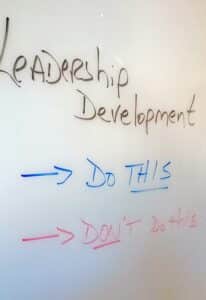
The problem is not complexity, effort or difficulty. Its wherewithal. Simply put, if you want it badly enough, you’ll do it, and do it right. If you don’t, you won’t.
There endeth the first lesson.
So, I’ve been doing this for a lot of years. Yes, it helps to have the background in senior-most leadership, the experience in working with myriad leaders of all ilk, the multiple industry and markets, and the opportunity to see a larger picture from an objective perspective. Yes, all of those help. But the basics for developing leaders is infinitely simpler than we make it out to be:
- Know what you want (in the way of leadership behaviors),
- Determine where you are today, and
- Develop to the gap (between 1 and 2).
Why then, do we struggle so? What makes this seemingly simple process turn into a complex behemoth when we decide to “just do it?” My guess… you’re doing it wrong.
Leadership development may not be difficult, but it is precise. There are some things you must do. And some things you must not do.
Developing leaders does not work if you…
- …relegate ownership to Human Resources (processes, yes, ownership, no). CEOs own leadership identification and development; that accountability should cascade down uniformly and appropriately throughout the organization. It cannot be driven from below.
- …rely solely on ivy walls. Look, I’m certain Harvard, Wharton, LSU, and even Texas A&M have wonderful leadership offerings; but by nature, they fill common gaps for common companies with common competency needs. You can’t mass-educate any other way. It’s like saying an MBA makes you a CEO; it doesn’t, of course. They can be great general foundations; they are, by design, lousy at specific developmental needs.
- …insist on the cheapest approach. No, this is not a “you must hire us” call to action; it’s simply a reality check. Do not entrust the future of your organization to the lowest-cost solution based solely on those costs.
- A local community college may have a management course;
- Fred Pryor seminars are ubiquitous;
- online learning shifts responsibility to the learner.
All of these solutions are relatively cheap… for a reason: they do not develop leaders. Pursue at your peril.
- …believe that someone else can do all the heavy lifting. You can hire my firm (or a similar one), use internal resources, or mentor via others in the organizations. None will be effective without consistent, relevant reinforcement.
Leaders can be developed successfully if you will…
- …make it a priority. Really. Not just eye-wash, but substantial amounts of senior leadership time and efforts must be part of the equation. You can’t say developing leaders is important while all your time is spent on something else. I mean, you can, but no one will buy it.
- …measure success as you would any other investment. In heaven’s name, why do many organizations still insist on after-class “smile” sheets? Not only are they useless to determine a return on leadership dollars, they are potentially dangerous, as they frequently mask poor developmental efforts. I can always max out a smile-sheet: have plenty of coffee, decent lunches, and let ‘em out early. Is that what we should use as a metric?
- …own reinforcement. The best developmental efforts include the “next-level” managers to ensure that relevant, timely reinforcement occurs. Facilitators and coaches cannot “do it” alone; you must be involved—and invested—in the development process to ensure success. Third parties like me and my firm can certainly help, but we can only take it from start to some mid-point; crossing the finish line—the heavy lifting I mentioned earlier—is the joint responsibility of the learner, his manager, and the facilitator/coach.
Developing leaders takes some effort, to be sure, but it’s just not all that hard. Remember the significance of successfully developed leaders, and make sure all you do around that reflects that significance. It’s important.

